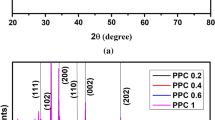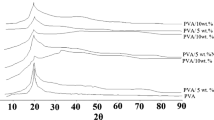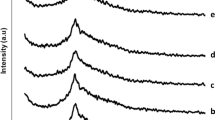Abstract
Films ≈350 μm of poly(vinyl-alcohol) composites, containing copper (Cu), aluminium (Al) and iron (Fe), metallic powder very fine, were prepared by a casting method. Thermal conductivity, phonon velocity, mean free path and specific heat were studied. The pure sample of PVA has a lower values of thermal conductivity than that which are doped with metals. For all samples the thermal conductivityK increases up to a certain temperatureT gg (120–160°C) and then decreases with temperature. The specific heat increase with temperature up to ≈120°C and above 120°C is nearly independent on temperature. The pure sample of PVA has small values of mean free path (L)≈0.2 Å at room temperature, but for PVA+ metalsL≈2.0 Å. The phonon velocity of pure PVA is larger than that of PVA containing metals.
Zusammenfassung
Mit Hilfe eines Gießverfahrens wurden ≈350 μm Filme aus Polyvinylalkohol mit Gehalt an sehr feinem Metallpulver aus Kupfer (Cu), Aluminium (Al) und Eisen (Fe) hergestellt. Es wurden thermische Leitfähigkeit, Phononengeschwindigkeit, mittlere freie Weglänge und spezifische Wärme untersucht. Die thermische Leitfähigkeit von reinem PVA besitzt geringere Werte als die von PVA mit Metallzusatz. Für alle Proben steigt die thermische Leit fähigkeitK bis zu einer gewissen TemperaturT gg (120–160°C) und sinkt dann mit zunehmender Temperatur wieder ab. Die spezifische Wärme steigt bis z einer Temperatur von etwa 120°C und ist darüber annähernd temperaturunabhängig. Die reinen PVA-Proben weisen bei Raumtemperatur kleine Werte für die mittlere freie Weglänge auf (L beträgt etwa 0.2 Å), jedoch für PVA+Metall beträgtL etwa 2.0 Å. Die Phenonengeschwindigkeit für reines PVA mit Metallgehalt.
Similar content being viewed by others
References
R. Peierls, J. Physik, 5 (1929) 3, 1055.
A. Eucken and G. Kuhn, Z. Physik. Chem., 134 (1928) 193.
I. Yoshida, J. Phys. Soc. Japan, 15 (1960) 12.
I. Yoshida, S. Nomura and S. Sawada, J. Phys. Soc. Japan, 13 (1958) 1550.
S. A. Olofa, A. Tawfik, M. M. Barakat and M. M. Mosaad, J. Thermal Anal., 37 (1991) 2272.
M. Kalnin and D. T. Turner, J. Mater. Sci. Lett., 4 (1985) 1476.
P. Hedvig, Dielectric spectroscopy of polymers, Hilger, Bristal 1977, p. 76.
G. I. Epifanov, Solid state physics, first editions, Mir publisher, 1979, p. 129.
J. S. Dugdale and D. K. C. MacDonald, Phys. Rev. 98 (1955) 1751.
P. G. Klemans, Proc. Roy. Soc. (London), A 208 (1956) 83.
J. S. Blackmore, Solid state physics, 2nd edition, Mir publisher 1988 p. 118.
Author information
Authors and Affiliations
Rights and permissions
About this article
Cite this article
Abdel-Ati, M.I., Hemeda, O.M., Mosaad, M.M. et al. Thermal properties of pure and doped (polyvinyl-alcohol) PVA. Journal of Thermal Analysis 42, 1113–1122 (1994). https://doi.org/10.1007/BF02546921
Received:
Revised:
Issue Date:
DOI: https://doi.org/10.1007/BF02546921




